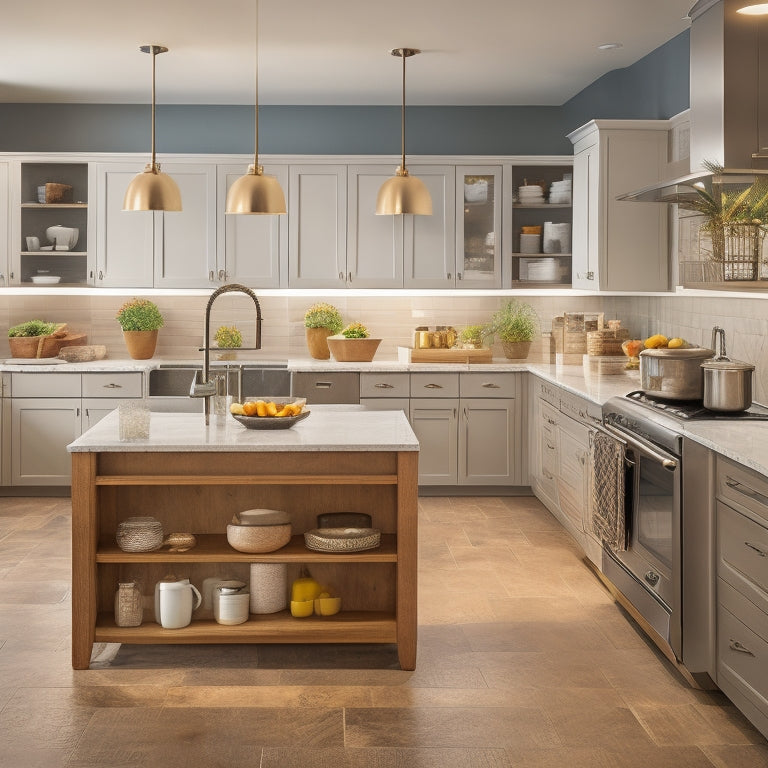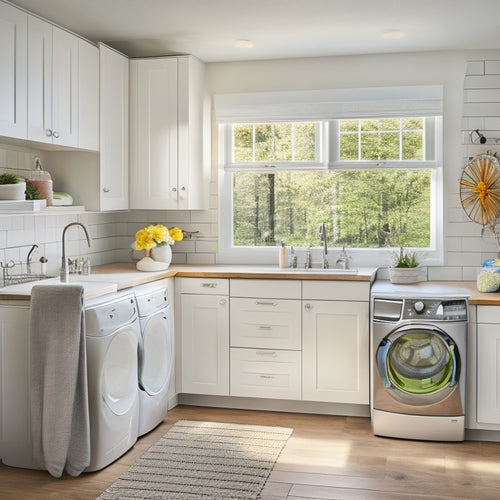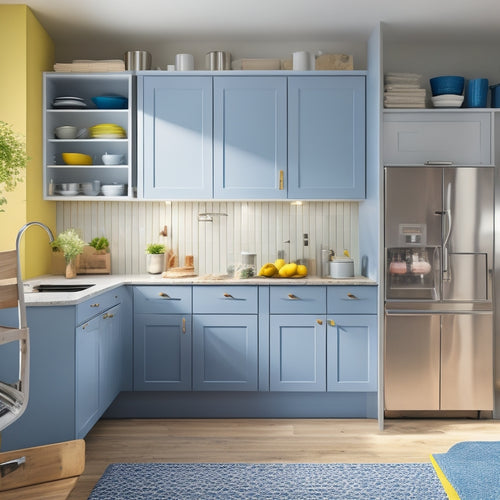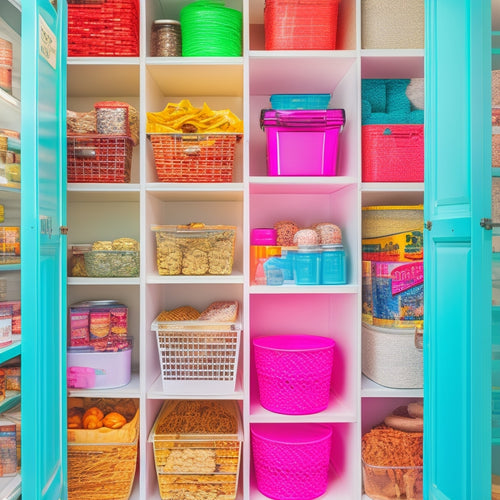
7 Essential Tips for a Gluten-Free Kitchen Design
Share
You're designing a gluten-free kitchen that's both safe and efficient. Start by creating dedicated zones for gluten-free food prep, separated by clean and defined spaces. Next, guarantee your countertops are sanitized with non-porous materials and regular cleaning schedules. Use color-coded labels for easy identification and assign specific tools to each cooking station. Prevent cross-contamination with designated areas for gluten-free food prep, cooking, and storage. Store special ingredients in airtight containers and keep cleaning essentials within arm's reach. With these essential tips, you're on your way to a stress-free gluten-free kitchen – and there's more to explore to make your space truly exceptional.
Key Takeaways
• Design dedicated gluten-free zones with separate cooking stations, storage, and utensils to minimize cross-contamination risks.
• Implement cleanliness measures like glass or acrylic partitions, stainless steel or wooden dividers, and flexible curtain dividers for safe food preparation.
• Assign specific tools to cooking stations and use vertical storage options to prevent cross-contamination and optimize kitchen organization.
• Choose non-porous countertop materials, establish regular cleaning schedules, and use gentle, gluten-free cleaning products for a sanitary environment.
• Use color-coded labels, utensils, and storage bins to differentiate gluten-free ingredients and products, ensuring efficient identification and reduced errors.
Dedicated Gluten-Free Zones
Carve out a safe haven in your kitchen by designating specific areas and tools for gluten-free food preparation, ensuring cross-contamination is minimized and your dietary needs are met. By creating dedicated zones, you'll feel more in control of your gluten-free lifestyle and reduce the risk of accidental exposure.
Visualize your kitchen as a series of zones, each with its own unique aesthetic. The gluten-free zone can be designed with calming colors and sleek lines, evoking a sense of serenity and tranquility. This zone can include a designated countertop, storage bins, and utensils that are exclusively used for gluten-free food preparation.
As you move through your kitchen, you'll appreciate the sense of organization and structure that these zones provide. You'll feel more confident in your ability to prepare gluten-free meals, and you'll enjoy the peace of mind that comes with knowing your health and well-being are protected.
Separate Cooking Stations
As you plan your separate cooking stations, think about creating a dedicated gluten-free zone, where you can prep and cook gluten-free meals without worrying about cross-contamination.
Visualize a clean, defined space, separated from the rest of the kitchen by clear barriers, where you can store designated tools and ingredients.
Dedicated Gluten-Free Zone
In a shared kitchen, designate a separate cooking station as your dedicated gluten-free zone, where you can prep, cook, and store gluten-free ingredients without fear of cross-contamination. This zone is your sanctuary, where you can live your gluten-free lifestyle without worrying about accidental exposure.
When designing this zone, think about aesthetics that promote a sense of calm and serenity. Choose a color scheme that soothes your senses, like soft blues or greens, and incorporate natural materials like wood or stone to create a warm and inviting atmosphere.
Make sure your zone is well-organized, with ample storage for your gluten-free ingredients and cooking essentials. Consider installing a separate countertop, sink, or stove to minimize the risk of cross-contamination. Add some greenery, like a small herb garden or a potted plant, to bring in a touch of nature and freshness.
Clean Cross-Contamination Barriers
To further safeguard your gluten-free zone, consider creating physical barriers between cooking stations to prevent cross-contamination. This containment strategy is essential in maintaining a safe environment for those with gluten intolerance or sensitivity.
Consider these effective ways to create clean cross-contamination barriers:
-
Glass or acrylic partitions: Install transparent partitions to separate cooking stations, allowing you to maintain visibility while preventing cross-contamination.
-
Stainless steel or wooden dividers: Use durable materials to create physical barriers between stations, making it easy to clean and maintain.
-
Flexible curtain dividers: Hang curtains made of easy-to-clean materials, such as vinyl or polyester, to create movable barriers between stations.
- Modular cooking stations: Design separate, self-contained cooking stations with built-in barriers, providing a dedicated space for gluten-free food preparation.
Designated Tool Storage
Assign a specific set of cooking tools and utensils to each cooking station, storing them in designated areas to prevent cross-contamination and guarantee that gluten-free and gluten-containing food preparation remain separate. This way, you'll avoid the risk of accidentally contaminating your gluten-free dishes with gluten.
Imagine having a dedicated gluten-free zone, where all the utensils and tools are safely stored and easily accessible. You'll feel more confident and in control of your cooking environment.
When designing your tool storage, consider the 'golden triangle' concept, where frequently used utensils are placed within easy reach. This will streamline your cooking process and reduce the risk of mistakes.
Use vertical storage options like wall-mounted racks or hooks to maximize your kitchen's vertical space and keep countertops clear. Label each storage area clearly, so you can quickly identify where each tool belongs.
Sanitized Countertops Matter
Picture yourself wiping down your countertops with a mixture of water and vinegar, watching as crumbs and spills disappear, leaving a sanitized surface that's safe for gluten-free food preparation. You take pride in maintaining a clean kitchen, and for good reason - cross-contamination is a serious concern for those with gluten intolerance.
When designing your gluten-free kitchen, don't overlook the importance of sanitized countertops.
Here are some essential tips to keep in mind:
-
Choose the right countertop materials: Opt for non-porous surfaces like stainless steel, granite, or quartz that are easy to clean and resistant to harboring bacteria.
-
Establish a cleaning schedule: Set reminders to wipe down countertops after each meal prep, and deep clean weekly to prevent crumbs and spills from building up.
-
Use the right cleaning products: Stick to gentle, gluten-free cleaning solutions that won't leave residues or compromise the integrity of your countertops.
- Don't forget the little things: Regularly clean countertop edges, corners, and crevices where crumbs and dust tend to accumulate.
Labeling for Easy Identification
As you design your gluten-free kitchen, you'll want to make sure everything has its designated place, and that means labeling for easy identification. You'll be creating a system that's both functional and visually appealing, making it a breeze to find what you need at a glance.
Color-Coded Storage Bins
In your gluten-free kitchen, you'll appreciate the visual appeal and functional simplicity of color-coded storage bins, which enable you to identify contents at a glance. This clever organization hack not only streamlines your storage but also creates an atmosphere of aesthetic harmony. By assigning a specific color to each type of ingredient or cooking essential, you'll maintain bin organization and reduce the risk of cross-contamination.
Here are some benefits of using color-coded storage bins:
-
Quick identification: Easily spot the bin containing the gluten-free flour or pasta, saving you time and frustration.
-
Reduced errors: Color-coding minimizes the chance of mistakenly grabbing the wrong ingredient, ensuring your dishes turn out gluten-free and delicious.
-
Streamlined workflow: With everything neatly categorized, you'll spend less time searching for ingredients and more time cooking up a storm.
- Visual appeal: Color-coded bins add a pop of color and visual interest to your kitchen, creating a welcoming space that inspires creativity and confidence.
Gluten-Free Zone Signage
By designating specific zones in your kitchen with clear signage, you're creating a visual system that helps you and others quickly identify where gluten-free ingredients and cooking essentials are stored. This visual hierarchy is crucial in maintaining a gluten-free kitchen, as it guarantees that everyone involved in meal prep can easily navigate the space.
To create an effective signage system, start by identifying the key zones in your kitchen, such as a gluten-free pantry or cooking station. Then, design signs that are visually appealing and easy to read. Consider using a consistent brand identity throughout your signage to create a cohesive look that reflects your personal style.
For instance, you could use a specific font, color scheme, or iconography to create a recognizable visual language. By doing so, you'll establish a sense of harmony and flow in your kitchen, making it a more enjoyable and inclusive space for everyone.
With clear signage, you'll be able to cook with confidence, knowing that your gluten-free essentials are easily accessible and identifiable.
Clear Shelf Labels
With clear shelf labels, you're creating a visual map of your gluten-free ingredients and cooking essentials, making it effortless to locate what you need at a glance. This thoughtful design element not only streamlines your cooking process but also contributes to an overall sense of aesthetic organization.
By labeling your shelves, you're tapping into the psychology of labeling, which suggests that our brains process visual information more efficiently than text. This means you'll spend less time searching for ingredients and more time enjoying the cooking process.
Here are some tips to get you started:
-
Keep it simple: Use a clean, easy-to-read font and avoid cluttering your labels with too much information.
-
Group similar items together: Store ingredients by category, such as baking supplies or spices, to create a sense of cohesion.
-
Use consistent labeling: Choose a labeling style and stick to it throughout your kitchen to create a sense of continuity.
- Don't forget the 'zones': Label specific areas of your kitchen, like a 'gluten-free baking station,' to create a sense of belonging and community.
Cross-Contamination Prevention
Your gluten-free kitchen design hinges on a critical component: the careful separation of gluten-containing and gluten-free zones to guarantee the prevention of cross-contamination. This is no trivial matter, as even the slightest misstep can lead to gluten exposure and serious health consequences.
To secure your kitchen remains a safe haven, designate specific areas for gluten-free food prep, cooking, and storage. Use gluten testing to verify the safety of your ingredients and identify potential contamination risks.
Visual cues can be a powerful tool in maintaining this separation. Consider using color-coded labels, utensils, and equipment to differentiate between gluten-containing and gluten-free zones. This will help you and others quickly identify which areas are safe for gluten-free food handling.
Additionally, implement strict cleaning protocols to prevent cross-contamination through shared surfaces and utensils. By taking these proactive steps, you'll create a kitchen environment where gluten-free living is both safe and enjoyable.
Storage for Special Ingredients
In your gluten-free kitchen, allocate a dedicated space for special ingredients, like ancient grains, nut flours, or specialty baking supplies, to guarantee easy access and visibility while preventing clutter and contamination.
To guarantee a well-organized pantry, follow these storage tips:
-
Designate a specific zone: Assign a specific shelf or cabinet for gluten-free ingredients to prevent cross-contamination and simplify meal prep.
-
Use airtight containers: Store ingredients in airtight containers to maintain freshness and prevent moisture from affecting texture and quality.
-
Label and categorize: Label containers and categorize ingredients by type (e.g., flours, baking supplies, etc.) to assure easy identification and access.
- Implement ingredient rotation: Store newer ingredients behind older ones to confirm older items are used before they expire, reducing waste and saving you money.
Easy Cleaning Essentials
Cleanliness is key in a gluten-free kitchen, so designate a convenient spot near the cooking station for a caddy or tray that holds essential cleaning supplies, such as all-purpose cleaners, disinfecting wipes, and scrubbers. This will guarantee that you can quickly clean up spills and crumbs, reducing the risk of cross-contamination.
You'll also want to stock up on microfiber cloths, which are gentle on surfaces but tough on dirt and grime.
When it comes to dishwashing, make sure you're using dishwasher-safe utensils and cookware to avoid any gluten residue. Check the labels to confirm that your dishes are safe for high-heat washing. Additionally, consider investing in a dishwasher with a sanitizing cycle to give your dishes an extra layer of protection.
Frequently Asked Questions
Can I Convert My Existing Kitchen to Gluten-Free Without Renovating?
You can convert your existing kitchen to gluten-free without renovating! Start by evaluating your space, prioritizing zones for gluten-free prep, and optimizing storage to guarantee a seamless change, creating a harmonious and inclusive cooking environment that makes you feel at home.
How Do I Balance Gluten-Free and Gluten-Containing Cooking in One Kitchen?
'Imagine a kitchen where gluten-free and gluten-containing culinary worlds collide - harmoniously! You'll need to navigate shared spaces with care, avoiding cross contamination like a masterful conductor, to guarantee both cuisines thrive in perfect harmony.'
Are There Any Specific Gluten-Free Kitchen Design Certifications I Should Look For?
When searching for a designer, you'll want to look for certifications like the Gluten-Free Certification Organization's (GFCO) Kitchen Designer Certification, ensuring your designer has undergone rigorous training and understands the intricacies of gluten-free design standards.
Can I Use the Same Utensils for Both Gluten-Free and Gluten-Containing Cooking?
'Imagine your utensils as tiny Trojan horses, potentially bringing gluten into your gluten-free zone. To avoid cross-contamination, you'll want to sanitize utensils thoroughly or have separate sets for gluten-free and gluten-containing cooking to guarantee your safety net.'
How Do I Ensure Gluten-Free Kitchen Design Compliance With Food Safety Regulations?
You'll guarantee compliance with food safety regulations by implementing a kitchen design that prevents cross contamination, meeting regulatory standards for separate prep areas, storage, and equipment - think dedicated zones, color-coded tools, and clever labeling!
Related Posts
-

Revamp Your Laundry Room With Smart Space-Saving
You're tired of feeling cramped and disorganized in your laundry room, and it's time to revamp the space to make the ...
-

Smart Storage Solutions for Small Kitchen Spaces
You're struggling to find space in your small kitchen, but don't worry, smart storage solutions can help. Start by ut...
-

Revamp Your Pantry With Dollar Store Hacks
You can transform your pantry from a cluttered disaster zone to a sleek and functional space with just a few trips to...


